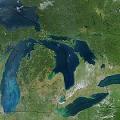 根據美國與加拿大合作的最新檢測報告指出,五大湖區的許多有毒化學含量正在減少之中,但值得注意的是,湖中還出現一些以往未發現過的新化學物質。
根據美國與加拿大合作的最新檢測報告指出,五大湖區的許多有毒化學含量正在減少之中,但值得注意的是,湖中還出現一些以往未發現過的新化學物質。
7日在芝加哥舉辦的國際聯合委員會會議上,美國環保署與加拿大環保署共同發表了上述結論。在這份《2007年五大湖區重點報告》中,五大湖區的復原及保存是今年報告的重點,其中表現優異的部分包含以下數點:
- 過去30年來,有毒化學物質在大湖區的空氣、水質、沉澱物、動植物有顯著的減少。
- 大湖區的水質依然是好的飲用水來源。
- 2005年間,五大湖區有74%以上的湖濱沙灘,有95%的泳季均開放遊憩。
- 鱒魚持續在五大湖區中的休倫湖(Huron)、蘇必利爾湖(Superior)自然繁育。
然而,表現較劣的部分包含:
- 新的化學物質,如防火材料多溴聯苯醚(polybrominated diphenyl ethers,PBDEs)、還有許多藥學及保養產品的化學物質,被檢測到的機率更區頻繁。
- 污染濃度雖減少了,湖中所捕獲的魚類仍不宜食用。
- 如斑馬紋貽貝(zebra mussels)、刺水蚤(spiny water fleas)等外來種持續入侵大湖區,破壞食物鏈。
- 野生動物排遺造成的細菌污染比先前所想像的更加嚴重。
- 結冰的範圍與時間縮減,且未來數年內,由於冬季期間的湖水蒸發,預期湖面水位將會下降。
- 持續的濕地流失與土地侵蝕,將會讓鳥類、兩棲類、魚類以及許多的野生動物喪失賴以維生的棲地。
- 由於湖岸開發與水泥化(shoreline hardening),再加上外來種入侵,水生生物的棲地更為惡化。
Levels of many toxic chemicals in the Great Lakes are diminishing, yet at the same time new chemicals of concern are being detected, according to the latest joint report from the United States and Canada.
The U.S. Environmental Protection Agency and Environment Canada released the 2007 State of the Great Lakes Highlights Report at the International Joint Commission meeting Thursday in Chicago.
These efforts to restore and preserve the Great Lakes are spotlighted in the 2007 State of the Great Lakes Highlights Report.
The good news is:
• Over the past 30 years there has been a marked reduction in the levels of toxic chemicals in the air, water, plants, animals, and sediment.
• Great Lakes continue to be a good source for treated drinking water.
• In 2005, 74 percent of monitored Great Lakes beaches in the U.S. and Canada were open more than 95 percent of the swimming season.
• Significant natural reproduction of lake trout is occurring in lakes Huron and Superior.
The bad news is:
• New chemicals of concern, like polybrominated diphenyl ethers used as flame retardants, and various pharmaceutical and personal care products, are being detected more frequently.
• Decline in contaminant concentrations has not eliminated the need for sport fish consumption advisories.
• Non-native species (zebra mussels, spiny water fleas) continue to invade the Great Lakes and impair the food web.
• Wildlife waste can be more of a contributing factor in bacterial contamination than previously thought.
• Declines in the duration and extent of ice cover on the Great Lakes and declines in lake levels due to evaporation during the winter are expected to occur in future years.
• Continuing wetlands loss and degradation results in loss of habitat for birds, amphibians, fish and wildlife.
• Aquatic habitats on the coasts continue to deteriorate due to development, shoreline hardening and non-native species.
全文及圖片詳見ENS報導




